NCERT Solutions for Exercise 2.3 Class 9 Maths Chapter 2 - Polynomials
NCERT Solutions for Class 9 Maths Chapter 2: Polynomials Exercise 2.3- Download Free PDF
NCERT solutions for exercise 2.3 class 9 maths chapter 2 Polynomials: An equation formed with variables, exponents, and coefficients together with operations and an equal sign is called a polynomial equation. Here In this exercise 2.3, we will look at polynomial division. The Class 9 Maths chapter 2 exercise 2.3 lists a few practice problems on polynomials that involve the factorization of higher-degree Polynomials with linear polynomials. The Class 9 Maths chapter 2 exercise 2.3 covers the topics like remainder theorem with examples. The concept of division of polynomials with linear polynomial expression over quadratic and cubic degrees will also be discussed in NCERT solutions for Class 9 Maths chapter 2 exercise 2.3.
This 9th class maths exercise 2.3 answers of NCERT Solution set comprises three questions, each with multiple parts, meticulously created by subject experts. The solutions are provided in a detailed, step-by-step format. Additionally, PDF versions of these class 9 maths chapter 2 exercise 2.3 solutions are available for convenient access and offline use. These resources are made accessible to students at no cost. Along with Class 9 Maths Chapter 1 Exercise 2.3 the following exercises are also present.
NCERT Solutions for Class 9 Maths Chapter 2 – Polynomials Exercise 2.3
Access Polynomials Class 9 Chapter 2 Exercise: 2.3
Q1 (i) Find the remainder when $x^3 + 3x^2 +3x + 1$ is divided by $x + 1$
Answer:
When we divide $x^3 + 3x^2 +3x + 1$ by $x + 1$ .
By long division method, we will get
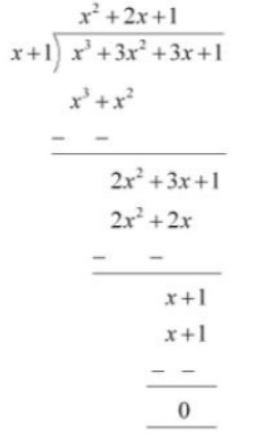
Therefore, remainder is $0$ .
Q1 (ii) Find the remainder when $x^3 + 3x^2 +3x + 1$ is divided by $x - \frac{1}{2}$
Answer:
When we divide $x^3 + 3x^2 +3x + 1$ by $x - \frac{1}{2}$ .
By long division method, we will get
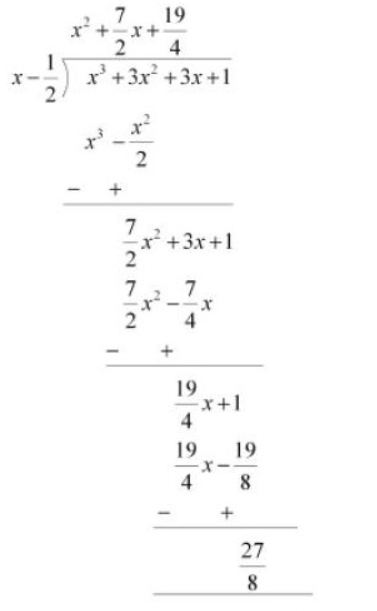 Therefore, the remainder is $\frac{27}{8}$
Therefore, the remainder is $\frac{27}{8}$
Q1 (iii) Find the remainder when $x^3 + 3x^2 +3x + 1$ is divided by $x$
Answer:
When we divide $x^3 + 3x^2 +3x + 1$ by $x$ .
By long division method, we will get
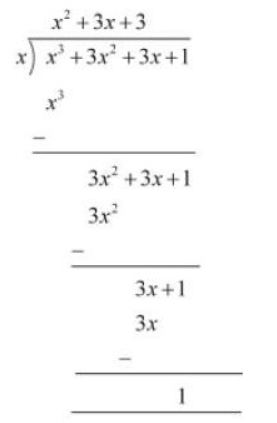
Therefore, remainder is $1$ .
Q1 (iv) Find the remainder when $x^3 + 3x^2 +3x + 1$ is divided by $x + \pi$
Answer:
When we divide $x^3 + 3x^2 +3x + 1$ by $x + \pi$ .
By long division method, we will get
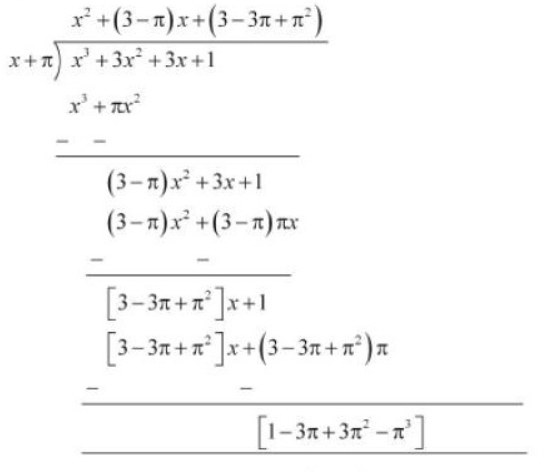
Therefore, the remainder is $1-3\pi + 3\pi^2-\pi^3$
Q1 (v) Find the remainder when $x^ 3 + 3x^ 2 + 3x + 1$ is divided by $5+2x$
Answer:
When we divide $x^3 + 3x^2 +3x + 1$ by $5+2x$ .
By long division method, we will get
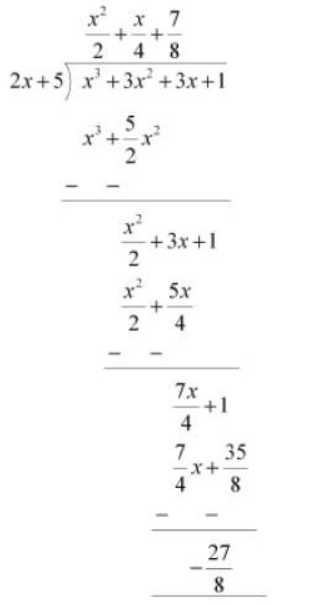
Therefore, the remainder is $-\frac{27}{8}$
Q2 Find the remainder when $x^3 - ax^2 + 6x - a$ is divided by $x - a$ .
Answer:
When we divide $x^3 - ax^2 + 6x - a$ by $x - a$ .
By long division method, we will get
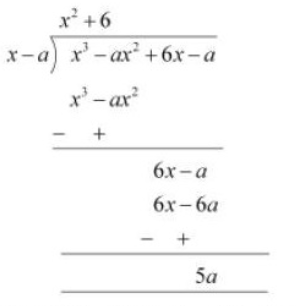
Therefore, remainder is $5a$
Q3 Check whether $7 + 3x$ is a factor of $3x^3 + 7x.$
Answer:
When we divide $3x^3 + 7x$ by $7 + 3x$ .
We can also write $3x^3 + 7x$ as $3x^3 +0x^2+ 7x$
By long division method, we will get
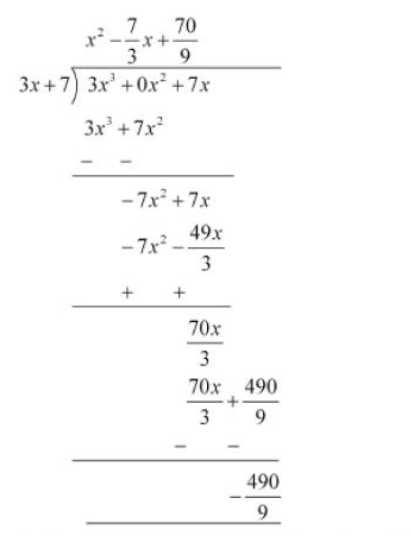
Since, remainder is not equal to 0
Therefore, $7 + 3x$ is not a factor of $3x^3 + 7x$
More About NCERT Solutions for Class 9 Maths Chapter 2 Exercise 2.3
There are a variety of questions starting from basic ones to advanced level exam pattern questions covered in NCERT solutions for Class 9 Maths chapter 2 exercise 2.3. The topics like remainder theorem, initiating the concept of algebraic division of polynomials, etc. Solutions of all the numerical questions of Class 9 Maths chapter 2 exercise, 2.3 with specified and student-friendly solutions are available in NCERT solutions for Class 9 Maths chapter 2 exercise 2.3. The basic idea of NCERT Class 9 Maths chapter 2 exercise 2.3 is to simplify mathematics for students, keeping this thing in mind the designing of NCERT solutions for Class 9 Maths chapter 2 exercise 2.3 is done.
Also Read| Polynomials Class 9 Notes
Benefits of NCERT Solutions for Class 9 Maths Chapter 2 Exercise 2.3
No. 1 benefit of solving exercise 2.3 Class 9 Maths is that the it give an idea to students how the questions can be solved.
The second most important benefit of this exercise 2.3 Class 9 Maths is that it acts as a base for the concept flow to exercise 2.4.
key Features of Exercise 2.3 Class 9 Maths
Comprehensive Exercise: 9th class maths exercise 2.3 answers is a comprehensive exercise that covers various topics related to polynomials.
Polynomial Division: This exercise 2.3 class 9 maths focuses on polynomial division, including both long division and synthetic division methods.
Divisor Polynomials: Students learn how to divide polynomials by divisor polynomials of different degrees.
- Diverse Problem Set: Class 9 maths ex 2.3 offers a variety of problems with different levels of complexity, allowing students to enhance their skills in polynomial division.
- Expert-Created Solutions: Class 9 ex 2.3 solution to the problems are typically provided in the exercise. These solutions are crafted by subject matter experts to ensure accuracy and clarity.
- PDF Availability: Students can often download a PDF version of the solutions,
Also see-
NCERT Solutions of Class 10 Subject Wise
Subject Wise NCERT Exemplar Solutions
Frequently Asked Questions (FAQs)
There are a total of 3 Questions that contain more than 7 practice problems to do.
Well if we talk about chapter 2 precisely then its upper variation will be covered in Class 10 where we will learn similar things with polynomials 2 and more variables
Since dividing quadratic is possible with linear polynomial because prior polynomial is of higher degree than the succeeding polynomial. Hence it is Possible
The highest power of given expression is x^6
Therefore degree of the polynomial is 6
The Remainder Theorem is a polynomial division technique based on Euclidean geometry. If we divide a polynomial P(x) by a factor (x – a), which isn't fundamentally an element of the polynomial, we get a smaller polynomial and a remainder polynomial, according to this theorem.
Popular Questions
Courses After 12th
Applications for Admissions are open.
As per latest syllabus. Physics formulas, equations, & laws of class 11 & 12th chapters
JEE Main Important Chemistry formulas
Get nowAs per latest syllabus. Chemistry formulas, equations, & laws of class 11 & 12th chapters
JEE Main high scoring chapters and topics
Get nowAs per latest 2024 syllabus. Study 40% syllabus and score upto 100% marks in JEE
JEE Main Important Mathematics Formulas
Get nowAs per latest syllabus. Maths formulas, equations, & theorems of class 11 & 12th chapters
